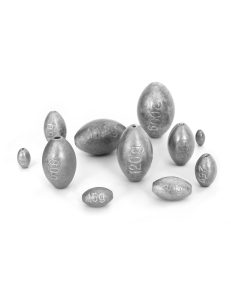Egg sinkers are a versatile and essential tool in any angler’s tackle box. These oval-shaped weights are perfect for various fishing techniques, particularly when bottom fishing or targeting species that swim close to the substrate. Understanding how to properly rig with egg sinkers can enhance your fishing success, whether you’re aiming for catfish, redfish, or bass. Here’s a complete guide to help you get started.
What Are Egg Sinkers?
Egg sinkers are small, rounded weights that resemble eggs (hence the name) with a hole running through the center. This design allows the line to pass through easily, enabling the sinker to slide along the fishing line. The key benefit of an egg sinker is that it allows bait to move naturally in the water, improving the chances of attracting fish without them feeling resistance from the weight.
These sinkers are available in various sizes, from a fraction of an ounce to several ounces, depending on the fishing conditions and target species. Heavier egg sinkers are ideal for fishing in strong currents, while lighter ones work well in calm waters.

Why Use Egg Sinkers?
The primary reason anglers use egg sinkers is their versatility. They are especially popular in bottom fishing setups where keeping the bait close to the bottom is essential. This is particularly useful when fishing for species like catfish, flounder, and redfish, which tend to stay near the substrate.
Egg sinkers also allow for a more natural bait presentation. Because the sinker moves freely along the line, the bait can drift and move naturally with the current, making it more appealing to fish. Additionally, the sliding design prevents fish from feeling the weight of the sinker, which can cause them to spit out the bait prematurely.
Step-by-Step Guide to Rigging with Egg Sinkers
- Choose the Right Sinker Size The size of the egg sinker should match the fishing conditions. In stronger currents or deeper waters, opt for a heavier sinker. For calm waters or shallow areas, lighter sinkers will suffice.
- Thread the Line Through the Sinker Start by threading the fishing line through the hole in the egg sinker. The sinker should slide freely along the line, so ensure there are no knots or kinks in the line that could hinder its movement.
- Add a Bead (Optional) Some anglers add a small plastic or glass bead between the egg sinker and the swivel or knot. The bead acts as a buffer, preventing the sinker from damaging the knot or weakening the line over time. This is especially useful when using heavier sinkers.
- Attach a Swivel After threading the sinker (and optional bead) onto the line, tie a swivel to the end of the line using a strong knot, such as the improved clinch knot. The swivel prevents the line from twisting and ensures that the sinker doesn’t slide down to the hook.
- Add a Leader Line To the other end of the swivel, tie a leader line. The length of the leader will depend on the species you’re targeting and the fishing conditions. A longer leader allows for more natural movement of the bait, while a shorter leader keeps the bait closer to the bottom.
- Attach the Hook Finally, tie your hook to the end of the leader using a strong knot. The hook size and type will depend on the type of bait and the species you’re targeting. For example, circle hooks are commonly used for bottom-dwelling species like catfish and redfish.
When to Use Egg Sinkers
Egg sinkers are ideal for various fishing scenarios, particularly when fishing near the bottom. Some popular applications include:
- Bottom Fishing: When targeting species that feed on or near the bottom, such as catfish or flounder, egg sinkers keep the bait close to the substrate.
- Fishing in Currents: The streamlined shape of egg sinkers makes them less prone to getting stuck in rocks or weeds, making them great for fishing in rivers or strong currents.
- Drift Fishing: When drifting along with the current, egg sinkers help the bait move naturally while maintaining contact with the bottom.
Now that you know more about using egg sinkers, get out there and land a lunker in your neck of the woods.
Image: bluewingfishing





